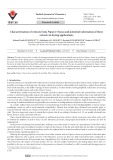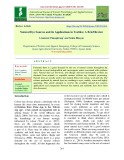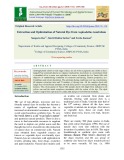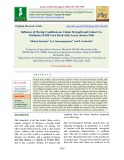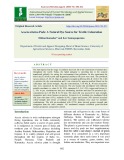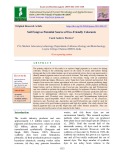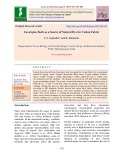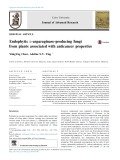
Source of natural dye
-
The aim of our work is to study the dyeing properties of extracts from natural sources such as Papaver rhoeas by modifying the conditions of the dyeing process, choosing other substrates that could be pretreated by innovative and environmentally friendly processes. The results obtained show a fairly high fixation of the extracts on the natural and artificial fibers. The use of mordants allowed the dye to be better fixed on the dyed fibers and to give several shades to the fabric. The rate of essential oil contained in Papaver rhoeas was considered important by the Clevenger process.
 9p
9p  tudichquannguyet
tudichquannguyet
 29-11-2021
29-11-2021
 7
7
 2
2
 Download
Download
-
Presently there is a great demand for the use of natural colours throughout the world due to non-biodegradable and carcinogenic nature associated with synthetic dyes. Natural dyes are non-toxic, non-allergic and non-carcinogenic as these are obtained from animals or vegetable matters without any chemical processing. Natural dyes are mostly used to dye natural fibers like cotton, wool and silk.
 9p
9p  chauchaungayxua10
chauchaungayxua10
 19-03-2021
19-03-2021
 9
9
 2
2
 Download
Download
-
Although plants exhibit a wide range of dyes, not all of these pigments can exhibit as dyes. Jangali Pyaz commonly known as vanpyaz (Asphodellus tenufolium) is a weed plant which is shredded off as a waste was exploited as a source of natural dye for Tassar Silk with objective of standardizing conditions of extraction and dyeing, fastness properties, ecofriendliness and colour absorption. The optimum dyeing conditions were 4g concentration, 60 minutes extraction time and 75 minutes of dyeing time.
 12p
12p  gaocaolon5
gaocaolon5
 14-06-2020
14-06-2020
 6
6
 1
1
 Download
Download
-
Natural dyes produce special aesthetic qualities which are environmentally friendly, add value to textile production as craftwork and as an industry. Today, many are rediscovering the joy of achieving colour through the use of renewable, non-toxic, natural sources.
 14p
14p  trinhthamhodang1213
trinhthamhodang1213
 29-05-2020
29-05-2020
 12
12
 1
1
 Download
Download
-
Extraction of natural dyes for the coloration of textile substrate is one the most important research area to the researchers. These dyes are considered to be very good for their colour experimentation quality, excellent for their endurance and soft lustrous colouring. They do not create any pollution problems as they are applied with simple chemical reactions. The wide verities of exotic shades produced by natural dyes are parallel with the synthetic range and hence can replace them with ease.
 12p
12p  nguaconbaynhay5
nguaconbaynhay5
 11-05-2020
11-05-2020
 18
18
 1
1
 Download
Download
-
The ban imposed on the usage of synthetic-dyes has led to the reinvention of natural-dyes throughout the world. Today, the faded antiquity is unveiling due to the concern manifested globally for saving the environment from pollution. In this experiment the dried Acacia nilotica pods and degummed mulberry-silk yarn were used. The powdered Acacia nilotica (5, 10, 15, 20g) was soaked overnight in different M.L.R (1:20, 1:30, 1:40) to optimize the dye-concentration and it was extracted by aqueous-method. Based on the reflectance and colour-strength, 10g dye-concentration, 1:30 M.L.
 11p
11p  trinhthamhodang4
trinhthamhodang4
 22-03-2020
22-03-2020
 10
10
 2
2
 Download
Download
-
The primary objective of this study is to explore fungal pigments as a source for dyeing colorants. Owing to the conflicting reports on the safety of textile and leathers during dyeing and due to the indiscriminate use of non-permitted colors, there is an urgent need to identify natural pigment sources as safe textile colorant. This study critically examines the potentials of fungi as sources production of biocolorant. Along with an established pigment producing fungus, Monascus, newer fungi have been explored and reported.
 16p
16p  cothumenhmong3
cothumenhmong3
 22-02-2020
22-02-2020
 27
27
 1
1
 Download
Download
-
Water is a essential source, nowadays days the resources of the water and its availability is lacking. Industrial pollutions like textiles, leather, food industries, pharmaceuticals are the major part of pollutants and creating a major problems. Especially textile areas, uses high colorant synthetic chemical dyes, and also recalcitrant, mutagenic in nature.
 5p
5p  chauchaungayxua3
chauchaungayxua3
 07-02-2020
07-02-2020
 5
5
 0
0
 Download
Download
-
Natural dye extracted from Eucalyptus bark was applied to cotton fabrics by conventional method of dyeing. Alum, Vinegar, Myrobolan, Betel leaves, Copper sulphate (CuSO4), Alum + CuSO4, Vinegar + CuSO4, Myrobalan + CuSO4, and Betel leaves + CuSO4 were the treatments used for mordants. The dyeing was carried out with and without mordants by pre-mordanting method. The colour of each dyed material was investigated in terms of CIELAB (L*, a* and b*) and K/S values by perimer color scan.
 11p
11p  nguathienthan2
nguathienthan2
 19-12-2019
19-12-2019
 7
7
 2
2
 Download
Download
-
The present study was undertaken to investigate the efficiency of natural printed fabric on UV protection. Arecanut slurry was powdered; sodium alginate and kokilaksha seed gums were used for the printing process. Optimization of printing recipe was done using 3 different ratios of dye sources with 0.5% combination of sodium alginate and kokilaksha seed gums. Screen printed samples were assessed for visual acceptance and colourfastness properties. Samples printed without mordant and with FeSO4 mordant using 0.
 7p
7p  cothumenhmong1
cothumenhmong1
 10-12-2019
10-12-2019
 18
18
 1
1
 Download
Download
-
Bixa orellana commonly known as annatto is one of the oldest known natural dye yielding plants native to Central and South America. Various parts of annatto have been widely used in the traditional medical system for prevention and treatment of a wide number of health disorders. The plethora of traditional uses has encouraged researchers to identify and isolate phytochemicals from all parts of this plant.
 16p
16p  kequaidan1
kequaidan1
 16-11-2019
16-11-2019
 18
18
 3
3
 Download
Download
-
Endophytes are novel sources of natural bioactive compounds. This study seeks endophytes that produce the anticancer enzyme L-asparaginase, to harness their potential for mass production. Four plants with anticancer properties; Cymbopogon citratus, Murraya koenigii, Oldenlandia diffusa and Pereskia bleo, were selected as host plants. L-Asparaginase-producing endophytes were detected by the formation of pink zones on agar, a result of hydrolyzes of asparagine into aspartic acid and ammonia that converts the phenol red dye indicator from yellow (acidic condition) to pink (alkaline condition).
 8p
8p  trinhthamhodang1
trinhthamhodang1
 16-11-2019
16-11-2019
 14
14
 0
0
 Download
Download
CHỦ ĐỀ BẠN MUỐN TÌM








